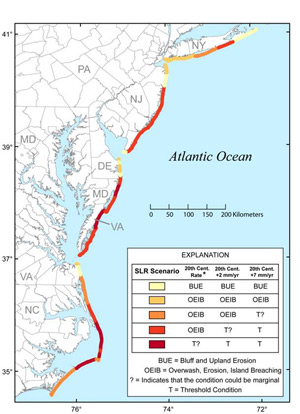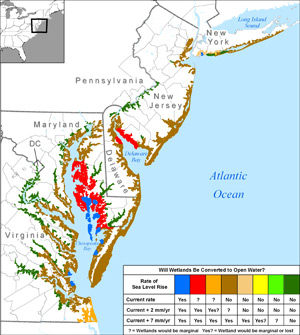Coastal Sensitivity to Sea Level Rise
Part I: The Physical Environment
Related Links
U.S. Global Change Research Program
Other EPA-sponsored Climate Change Science Program Synthesis and Assessment Reports
The U.S. Environmental Protection Agency (EPA), in collaboration with the U.S. Geological Survey (USGS) and the National Oceanic and Atmospheric Administration (NOAA), has released a report that discusses the impacts of sea-level rise on the physical characteristics of the coast, on coastal communities, and the habitats that depend on them. The report, Coastal Sensitivity to Sea-level Rise: A Focus on the Mid-Atlantic Region examines multiple opportunities for governments and coastal communities to plan for and adapt to rising sea levels.
Download specific chapters from Part I: The Physical Environment
- Chapter 1: Sea Level Rise and Its Effects (17 pp, 6.6MB)
- Chapter 2: Coastal Elevations (online summary and PDF)
- Chapter 3: Ocean Coasts (online summary and PDF)
- Chapter 4: Coastal Wetland Sustainability (online summary and PDF)
- Chapter 5: Vulnerable Species (online summary and PDF)
Part I examines the potential physical and environmental impacts of sea-level rise on the coastal environments of the mid-Atlantic region. Rising sea level over the next century will have a range of effects on coastal regions, including land loss and shoreline retreat from erosion and inundation, an increase in the frequency of storm-related flooding, and intrusion of saltwater into coastal freshwater aquifers. The sensitivity of a coastal region to sea-level rise depends both on the physical aspects (shape and composition) of a coastal landscape and the ecological setting. One of the most obvious impacts is that there will be land loss as coastal areas are inundated and eroded. Rising sea level will not only inundate the landscape but will also be a driver of change for the coastal landscape. These impacts will have large effects on natural environments such as coastal wetland ecosystems, as well as effects on human development in coastal regions (see Part II of this report). Making long-term projections of coastal change is difficult because of the multiple, interacting factors that contribute to that change. Given the large potential impacts to human and natural environments, there is a need to improve our ability to conduct long-term projections.
Part I describes the physical settings of the mid-Atlantic coast as well as the processes that influence shoreline change and land loss in response to sea-level rise. Part I also provides an assessment of coastal changes that may occur over the 21st century, as well as the consequences of those changes for coastal habitats and the flora and fauna they support.


Chapter 1 provides an overview of the current understanding of climate change and sea-level rise and their potential effects on both natural environments and society, and summarizes the background information that was used to develop this Product. Sea-level rise will have a range of impacts to both natural systems and human development and infrastructure in coastal regions. A major challenge is to understand the extent of these impacts and how to develop planning and adaption strategies that address both the quality of the natural environment and human interests.
Chapter 2 highlights the important issues in analysis of sea-level rise vulnerability based on coastal elevation data. Elevation is a critical factor in determining vulnerability to inundation, which will be the primary response to sea-level rise for only some locations in the mid-Atlantic region. Because sea-level rise impact assessments often rely on elevation data, it is important to understand the inherent accuracy of the underlying data and its effects on the uncertainty of any resulting vulnerability maps and statistical summaries. The existing studies of sea-level rise vulnerability in the Mid-Atlantic based on currently available elevation data do not provide the level of confidence that is optimal for local decision making. However, recent research using newer high-resolution, high accuracy elevation data is leading toward development of improved capabilities for vulnerability assessments.
Chapter 3 summarizes the factors and processes controlling the dynamics of ocean coasts. The major factor affecting the location and shape of coasts at centennial and longer time scales is global sea-level change, which is linked to the Earth’s climate. These close linkages are well documented in the scientific literature from field studies conducted over the past few decades. The details of the process-response relationships, however, are the subject of active, ongoing research. The general characteristics and shape of the coast (coastal morphology) reflects complex and ongoing interactions between changes in sea level, the physical processes that act on the coast (hydrodynamic regime, e.g., waves and tidal characteristics), the availability of sediment (sediment supply) transported by waves and tidal currents at the shore, and underlying geology (the structure and composition of the landscape which is often referred to as the geologic framework). Variations in these three factors are responsible for the different coastal landforms and environments occurring in the coastal regions of the United States. Chapter 3 presents a synthesis and assessment of the potential changes that can be expected for the mid-Atlantic shores of the United States which are primarily comprised of beaches and barrier islands.
Chapter 4 describes the vulnerability of coastal wetlands in the mid-Atlantic region to current and future sea-level rise. The fate of coastal wetlands is determined in large part by the way in which wetland vertical development processes change with climate drivers. In addition, the processes by which wetlands build vertically vary by geomorphic setting. Chapter 4 identifies those important climate drivers affecting wetland vertical development in the geomorphic settings of the mid-Atlantic region. The information on climate drivers, wetland vertical development, geomorphic settings, and local sea-level rise trends was synthesized and assessed using an expert decision process to determine wetland vulnerability for each geomorphic setting in each subregion of the mid-Atlantic region.

Chapter 5 summarizes the potential impacts to biota as a result of habitat change or loss driven by sea-level rise. Habitat quality, extent, and spatial distribution will change as a result of shore erosion, wetland loss, and shifts in estuarine salinity gradients. Of particular concern is the loss of wetland habitats and the important ecosystem functions they provide, which include critical habitat for wildlife, the trapping of sediments, nutrients, and pollutants, the cycling of nutrients and minerals, the buffering of storm impacts on coastal environments, and the exchange of materials with adjacent ecosystems.
- For previous reports focused on the implications of rising sea level, go to More Sea Level Rise Reports.

